Investigating the Galaxy Nexus LTE Signal Issue
by Brian Klug on December 19, 2011 8:24 PM EST- Posted in
- Smartphones
- Verizon
- LTE
- Droid Charge
- Mobile
- galaxy nexus
- Android 4.0
It seems that each time an LTE handset comes out, there’s invariably some perceived issue with connectivity and stability. This time, focus is being placed on Verizon’s CDMA/LTE variant of the Galaxy Nexus, and the issue surrounds LTE connectivity robustness compared to the other LTE handsets out there.
I’ve been running battery life tests on our LTE Galaxy Nexus review unit since release day (a process that takes a considerable amount of time and results in our reviews posting a while behind everyone else’s), but have had some time to run tests and gauge subjective performance. I found that LTE connectivity and performance felt above average, subjectively, and noted that in a tweet. After complaints started to surface, I spent a considerable amount of time reading the threads on XDA and other places around the web trying to discern what the complaints are about. I’ve seen a couple of big misconceptions that I think really get to the heart of the matter.
First off, is some background. The Verizon CDMA/LTE Galaxy Nexus (codename “mysid”) uses a combination of Samsung CMC221 and Via Telecom CBP 7.1 for LTE and CDMA 1x/EVDO connectivity, respectively. This is virtually identical (unsurprisingly) to the Droid Charge, which used a CMC220 for LTE and the same CBP 7.1. The CMC22x family is UE Category 3, which currently is the highest for shipping devices and means it can handle up to 100 Mbps downstream with 20 MHz FDD. To date, all of the LTE basebands in Verizon LTE devices have been UE category 3 with the exception of Motorola’s devices, which are all UE category 2, but I digress. We’ve reached out to Samsung Semiconductor about what’s changed between CMC220 and 221, but doubtless the changes improve connection stability and reliability.
Speeds thus far have also been excellent. I’ve squeezed in 183 speedtests between battery life testing, and have seen some of the fastest LTE connectivity out of the Galaxy Nexus to date. After testing so many Motorola LTE devices with UE Category 2 modems, it’s refreshing to see this kind of performance out of a UE Category 3 device.
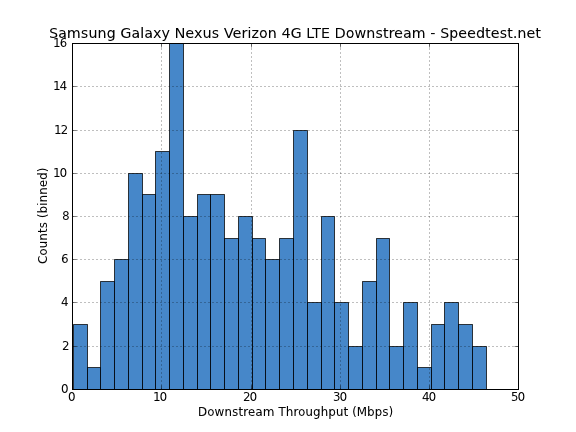
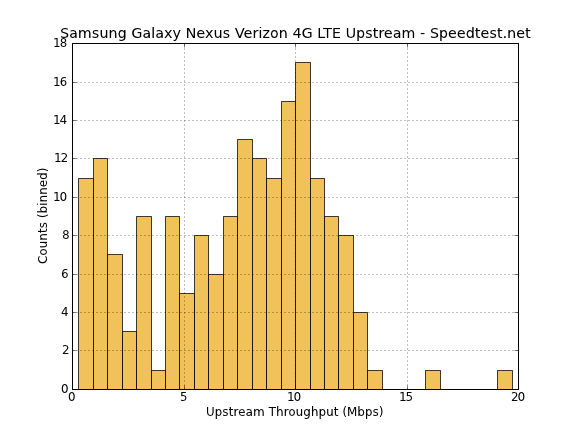
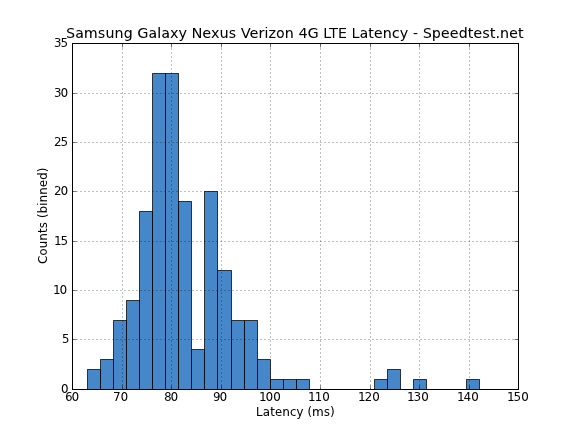
The issue that most people talk about centers around signal strength, and this is where a few misconceptions kick in. I’ve gotten a few emails and tweets and read pages on forums where people are implicitly comparing CDMA2000 1x/EVDO field strength to LTE field strength. The issue here is that on basically all of the LTE/CDMA Verizon handsets, the field under “Signal Strength” in about refers to EVDO signal strength, and not LTE signal strength. The two aren’t comparable at all for a host of reasons - different spectrum (800 MHz and 1900 MHz for 1x/EVDO as opposed to 700 MHz for LTE), and different cells (there’s some correlation, but not every Verizon base station has LTE onboard). The end result is that if you’re comparing 1x/EVDO signal strength to LTE signal strength, you’re making an absolutely meaningless apples to oranges comparison.
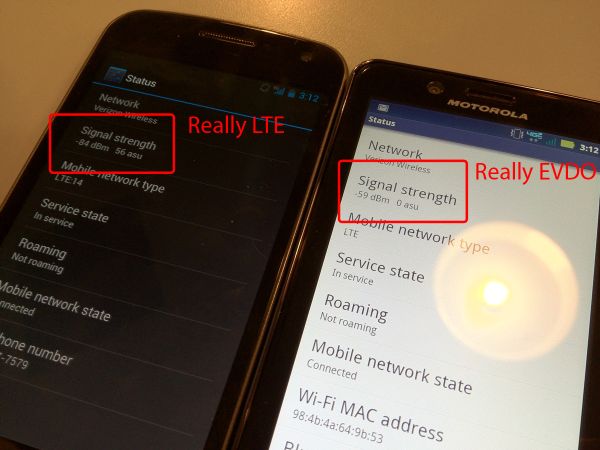
This is not a valid comparison - LTE versus EVDO signal strength
The Galaxy Nexus (and really just Android 4.0) now correctly reports and accommodates LTE by reporting its signal strength under “About->Status” and visualizing that as bars appropriately. Switch to EVDO on the Galaxy Nexus and signal strength appropriately changes to reflect an entirely different air interface’s signal strength. It’s nice to see people using dBm instead of bars when possible (which are effectively meaningless as a comparison metric), but now that there are multiple air interfaces on handsets, we have to be explicit about what numbers we’re actually comparing.
This reporting is a problem I’ve talked about at length in more than one LTE handset review, and to date I only know of ways to show LTE signal strength and channel quality on a few handsets. Samsung’s Droid Charge (courtesy Samsung’s excellent ServiceMode application viewed through *#0011# after some unlock trickery) and the Bionic (through logcat and grepping for the radio signal status daemon) report LTE field strength, but only if you dig for them.
Comparing LTE Signal Strength the Right Way
So how does the LTE Galaxy Nexus compare to the Droid Charge and Bionic, the two handsets we can actually view LTE signal strength in dBm on? Very closely as a matter of fact.
I have a Bionic kicking around which has to go back very soon, but fired up logcat and put the Galaxy Nexus next to it. The Bionic reports signal strength pretty constantly whereas in Android 4.0 the number has some hysteresis, but here the numbers are pretty darn close, with the Bionic hovering between -91 and -95 dBm, and the Galaxy Nexus reporting an average of -92 dBm.
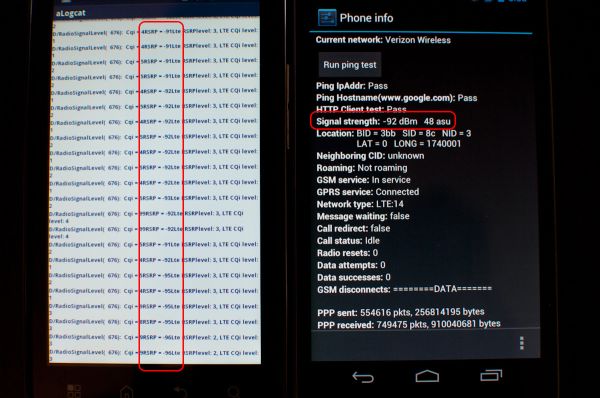
Left: Motorola Droid Bionic (logcat showing LTE signal strength), Right: Galaxy Nexus
Since the Droid Charge is the only other handset I know how to show LTE signal strength on, I tracked a friend down at a local cafe with one and fired up service mode. Again, what’s shown under “About->Status” on the Droid Charge is actually EVDO signal strength. Here the Galaxy Nexus shows -107 dBm and the Droid Charge shows -108 dBm.
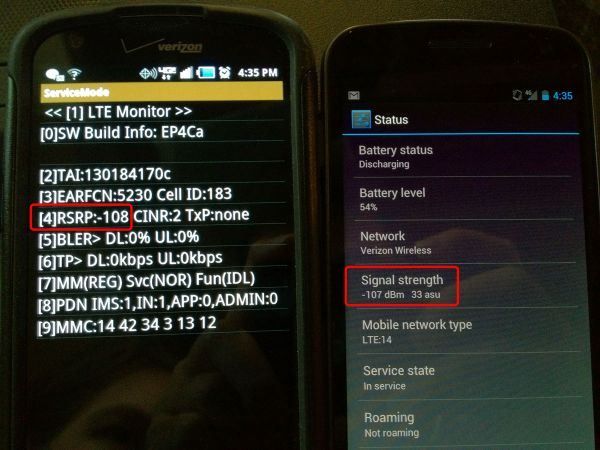
Left: Samsung Droid Charge (ServiceMode) Right: Galaxy Nexus
The Droid Charge is another hilarious example of why you can’t compare bars at all, as the Charge shows a positively laughable 4 out of 5 bars in an area with very low LTE signal strength, whereas the Galaxy Nexus (moreover, Android 4.0) has a very conservative and realistic strength to bars mapping. Carriers love to make things out to be better than they really are, however, and the result is this kind of hilarious visualization which portrays LTE signal as being much better than it really is if you stare at bars all day.
Verizon confirming though a tweet that there’s some sort of signal issue affecting the Galaxy Nexus confuses me, since from my perspective there isn’t any issue at all. The only real issue that exists is that the Galaxy Nexus (and really just the stock Android 4.0 signal strength to bars mapping) doesn’t line up with what Verizon has shipped on other devices, thus leading people to make apples to oranges comparisons and imagine an issue. I wager that some of this confusion is also compounded from the number of Verizon customers that are just now getting their first LTE handset with the Galaxy Nexus. It might be surprising to discover that LTE coverage right now isn't nearly as good as 1x/EVDO, but these things will improve as the carrier's LTE rollout continues. The other big disclamer is that I haven't fully investigated 1x/EVDO performance on the Galaxy Nexus, but this will end up being virtually identical to the Droid Charge.
There’s a CDMA and LTE baseband update coming with the LTE Galaxy Nexus’ 4.0.3 update as shown above, but this will likely do more to address connection stability than change the way anything is reported. Given how much attention this has gotten, however, I would not be surprised to see Google make a change to its signal strength to bars mapping for LTE and placebo away an issue that never really existed to begin with. That's also an unfortunate change, since from my perspective the Galaxy Nexus is one of the first handets that doesn't have an unrealistic mapping. In the meantime, we're still working on our Galaxy Nexus review where we'll take a complete look at the LTE/CDMA and GSM/UMTS Galaxy Nexii.
Update:
As predicted, Verizon has made a statement to The Verge and Computerworld stating that there's nothing wrong with the RF performance characteristics or baseband firmware on the LTE/CDMA Galaxy Nexus. Instead, they will upstream some changes to Android to make the device report its bars visualization in line with the rest of its 4G LTE hardware portfolio.
"[Verizon] will adjust the signal strength indicator to more closely match other Verizon Wireless devices.


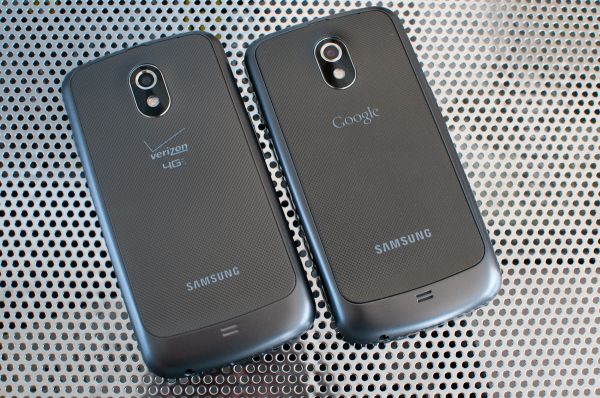









154 Comments
View All Comments
randy klimek - Thursday, December 22, 2011 - link
This article means nothing other than you cant go by bars on your phone between two samsung products(both have horrible reception in real world,not bench mark tests)and a motorola device,not one htc device was mentioned at all.there should be at least a mention of the htc thunderbolt since that was the first lte device to hit verizon.If your going to publish a article that has a biast opinion for samsung at least do a full study.barncii - Friday, December 23, 2011 - link
As always, great article. I have recently purchased the phone and im a little worried. I do not live in a 4G area so i cant speak on those issues. My concerns are with the 1x, which i have never seen, i dont know if this phone cannot display it or not. And more importantly the signal strenth on 3g. I never trust the signal bars, coming from a droid x which never properly displayed them.i have always checked the dbm meter in the about phone settings. When comparing the dbm reading on both phones there is a big difference. My droid x typically runs on the -90s at my home. At the same locaton and others the galaxy nexus will almost stay on -120. Have you compared the 3g signal to ther phones? Thanks again.houndawg3 - Saturday, December 24, 2011 - link
I think you're letting your over-massaged brain get in the way of reality. This has nothing to do with people misinterpreting bars or reading the wrong numbers. People are having real problems with signal. Not being able to get data connections and make phone calls constitute a real problem. Now, probably because of your BS article, Verizon is saying there's no problem. I have an idea. Quit writing articlea about stuff you have no idea about.Gasaraki88 - Tuesday, December 27, 2011 - link
Testing the phone in strong signal areas is useless. I could careless about 10mb/sec vs 20mb/sec. I have the Droid X and the GNex would drop data sometimes for no reason both 3g and 4g. I was in a very strong 4g area and it dropped data for no reason.Go test the phones at a weak signal area.
jmcb - Saturday, December 31, 2011 - link
Exactly....cuz some like me live n work in a bad reception areas. And we all dont have the luxury of being in good to great reception areas on a daily basis.Its almost exactly like the iPhone 4 issue....cant really be seen unless in a bad reception area.
Pureburn - Wednesday, December 28, 2011 - link
So all these graphs are nice to look at and all but how does your "study" and "non-issue" respond to the fact that in a strong 3G area, my GNexus has NO SERVICE (as in if I try to connect to any internet based application, it tells me it cannot) and my friend's Razr about 10 feet away from it has full service and quickly connects to internet applications and websites.This is not an issue of bars, it's an issue of the Galaxy Nexus simply cannot get a connection in places where other 3G and 3G/LTE VZW phones can. I am far from the only one having this problem - it is a critical problem that needs to be addressed or on 1/15/11, VZW will be getting a good chunk of these devices back.
xsoulbrothax - Wednesday, December 28, 2011 - link
Same here - I was looking into this because my phone essentially hasn't had 4G service since I woke up this morning, and it's been dropping 3G completely and losing data for chunks of time during the day.dcdttu - Monday, January 9, 2012 - link
I think you should go ahead and test the 1x/EVDO connectivity on the phone. I am sure you'll find it not identical to the Droid Charge. I've tested multiple Nexus with multiple other Verizon phones and none are near as bad as the Nexus at 3G reception, incl. the Droid Charge. Always 10-20dBm better.Garstud - Wednesday, January 18, 2012 - link
I have the same poor experience compared to the bionic. Any update of these test results?pltommyo - Friday, January 27, 2012 - link
Sitting here with my Thunderbolt pulling 7Mbs on a strong 4G LTE signal while my Nexus Galaxy cannot even get 3G. I have to connect ti WiFi ... weakly. Not looking at the bars or dBa figures ... im looking at the connection network and Speedtest results. The Nexus Gslaxy has a problem no doubts at all